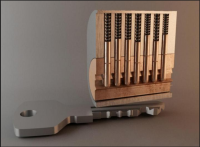








The pin tumbler lock (or Yale lock, after lock manufacturers Yale) is a lock mechanism that uses pins of varying lengths to prevent the lock from opening without the correct key. Pin tumblers are most commonly employed in cylinder locks, but may also be found in tubular pin tumbler locks (also known as radial locks).
The first tumbler lock was found in the ruins of the Palace of Khorsabad in Iraq.Basic principles of the pin tumbler lock may date as far back as 4000 BC in Egypt; the lock consisted of a wooden post affixed to the door, and a horizontal bolt that slid into the post. The bolt had vertical openings into which a set of pins fitted. These could be lifted, using a key, to a sufficient height to allow the bolt to move and unlock the door.This wooden lock was one of Egypt's major developments in domestic architecture during classical times.It was referred to in the Bible in Isaiah 22:22. ""I will place on his shoulder the key to the house of David; what he opens no one can shut, and what he shuts no one can open.""
In 1805, the earliest patent for a double-acting pin tumbler lock was granted to American physician Abraham O. Stansbury in England. It was based on earlier Egyptian locks and Joseph Bramah's tubular pin tumbler lock. Two years later, Stansbury was granted a patent in the United States for his lock.
In 1848, Linus Yale, Sr. invented the modern pin-tumbler lock.In 1861, Linus Yale, Jr. was inspired by the original 1840s pin-tumbler lock designed by his father, thus inventing and patenting a smaller flat key with serrated edges as well as pins of varying lengths within the lock itself, the same design of the pin-tumbler lock in use today.The modern Yale lock is essentially a more developed version of the Egyptian lock.